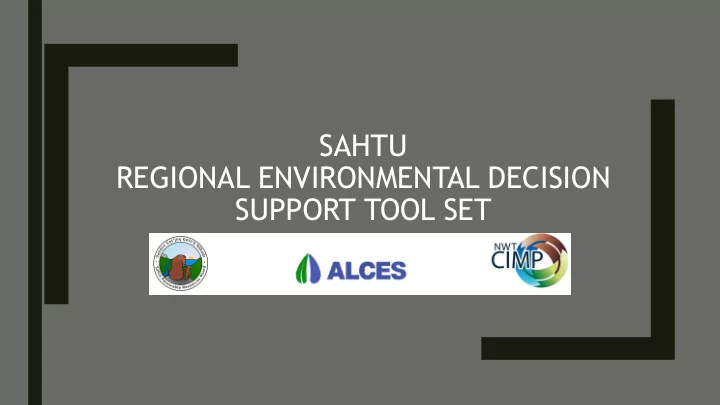

SAHTU REGIONAL ENVIRONMENTAL DECISION SUPPORT TOOL SET
Objectives ■ To Support Decision-Making: – To assess current and future cumulative effects of land use ■ To Communicate Trends: – To visually communicate environmental trends and consequences of alternative scenarios ■ To Collaborate: – To integrate Sahtu research and data projects and apply western and traditional knowledge to review changes to the landscape
Work Year One ■ – Integrate Regional Data Approach – Workshop on Uses of Decision- Support Tool ■ Year Two – Forecast Future Land Use Change Collaborate with Research – Workshop on Priority Areas Teams – Identify how to use local knowledge Annual Workshops with the Sahtu ERM Forum ■ Year Three – Integrate local knowledge – Deliver priority pilot studies – Prepare Sahtu Atlas
How it Works: Example Future: • Data + Boreal Caribou • GIS + Range • Simulation = Disturbance, 2030 • Future Landscapes Geographic Dynamic Information Landscape System & Landuse (GIS) Simulator 4
Exploring Alternative Futures for the Sahtu Looking at Futures: Water Quality/Quantity • Natural Resources • • Food Security • Climate Change What-If Scenario B? Infrastructure • Sustainability What-If Scenario A? Mid 1800’s 2015 2015 2060 5
Looking Forwards (and backwards) Natural features (climate) and land uses (roads) change in time. Sahtu ALCES can help show what the future may (or did) look like. 1950 1960 1970 1980 1990 2000 2010 2020 2030 2040 2050 6
Track all Relevant Land Uses Conservation Forestry Towns Areas Trapping Tourism Energy Hunting Recreation Human Hunting, Mining Population Fishing Plants, Roads, Assorted Berry Transport Industry Picking 7
Track all relevant Natural Processes Climate and Carbon Climate Pool Change Dynamics Hydrological Wildlife Cycle Habitat Natural Wildlife Disturbance Populations Regimes Plant Landscape Community Metrics Dynamics 8
Sahtu ALCES Results Graphs 2-D Maps Histograms 3-D Maps Sahtu Atlas 9
Sahtu Landscape Landscape composition today An Atlas of the Sahtu
Flora Physical Introduction Sahtu ALCES Data Points Data, Metrics, Outputs Population Zoning Land Uses Footprints Input and Outputs Extras Landscape Metrics
Total Forest Cover % of Landbase covered by forest
Water % of area covered by water
Wetland Wetland areas
Other Natural Cover Shrub, rock, etc.
Footprints Sahtu Land Use Scenario: NWT Statistics Population Growth ■ into the Mackenzie Valley Highway built 2027 ■ Future ■ Shale Oil development starts after 2027 ■ Climate WMC model Selwyn Mine built after 2027 ■ What will change? What future scenario(s) could Data Sources Include: be used? NWT Statistics ■ ■ Climate WMC Model ■ NWT Geomatics/ Discovery Portal Data National Forestry Database ■ National Energy Board ■
2010 Energy Footprint 2010
2030 Energy Footprint 2030
2060 Energy Footprint 2060
2010 Transport Footprint
2060 Transport Footprint Assumes Mackenzie Highway built in 2027
Footprint ■ Energy Movies ■ Transportation 2010 - 2060 ■ Total Footprint
Forest Age and Fire Time Since Last Fire, 2060
Forest Age, with Climate Change 2010 2060
Forest Age in 2060 No Climate Change With Climate Change
Boreal Caribou Predicting changes to Boreal Caribou
Boreal Caribou Disturbance 2010 2060
Boreal Caribou Disturbance 2060 No Climate Change With Climate Change
What Issues to Review? What Environmental Issues and Sahtu Regions are a Priority? • Mountain Caribou • Climate Change Shale Oil • Mountain ■ Great Bear Lake Watershed • Mountain and Barren Land Caribou Ranges ■ Others •
What Future Scenario? What will the Future be Made of? Mackenzie Valley Highway • Population • • Climate Change • Natural Resource Development
Who Should Collaborate? Current Collaborators: NWT Wildlife (Caribou) • • Co-Management Bodies, Regulators • Canadian Wildlife Service (Land Birds) • Others
How can we work with Traditional Information? Develop traditional ■ knowledge information to inform decision-making ■ Integrate data together to help forecast Sahtu futures ■ Looking Backward, together
MAHSI MATT CARLSON THOM STUBBS SAHTU CIMP 178
Recommend
More recommend